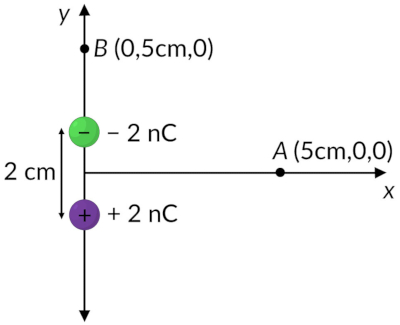24.7:
Calculations of Electric Potential II
1,343 Views
•
•
An electric dipole is a system of two equal but opposite charges, separated by a fixed distance. This system is used to model many real-world systems, including atomic and molecular interactions. One of these systems is the water molecule, but only under certain circumstances. These circumstances are met inside a microwave oven, where electric fields with alternating directions make the water molecules change orientation. This vibration is equivalent to heat at the molecular level.
Consider a dipole with charges 2 nC and -2 nC, with a separation of 2 cm between them, situated at the origin. What will be the electric potential due to this dipole at positions A (5 cm, 0, 0), and B (0, 5 cm, 0)?

The electric potential due to the dipole is given by the following equation
For position A, the electric potential is calculated on the x-axis, for which the angle between the position vector and the dipole moment is 90 degrees. Therefore the electric potential due to the given electric dipole at position A is
For position B, the electric potential is calculated on the y-axis, for which the angle between the position vector and the dipole moment is 0 degrees. Therefore the electric potential due to the given electric dipole at position B is
